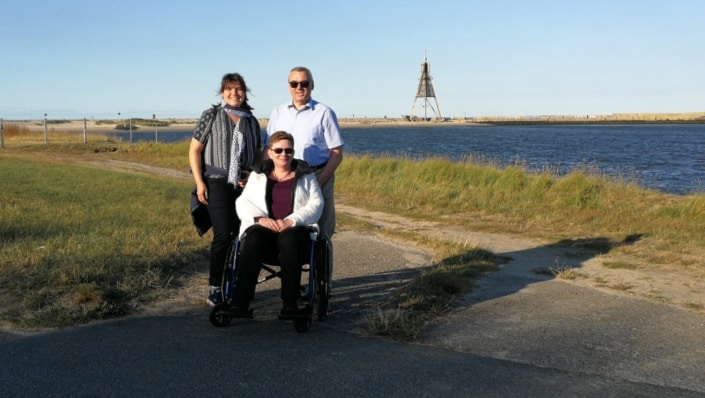My TM Story by Susanne Prüser
I will always remember May 9, 2015. During my morning routine, I felt unusually exhausted. I chalked it up to the flu, which all my children had during the previous week. The exhaustion intensified throughout the day. That evening, I visited a friend’s birthday party with my family. I began to feel excruciating pain in my upper arm. We went home and I took some painkillers to try and sleep. Three hours (and many tears) later, the pain subsided, and I was able to sleep for a few hours. The following morning I felt dizzy and exhausted. After a quick shower I had to lie down again. During the next few days, I experienced constant pain in my neck, weird sensations (numbness, tingling and burning sensations in my arms and legs), and extreme fatigue. I couldn’t walk more than 40 m or lift any weight due to muscle weakness. I couldn’t get from the first to the third floor of the house without pausing.
More than a week passed, but the pain in my neck, sensations throughout my whole body, and spasticity in my right side from neck to toe continued to increase. I then realized that this couldn’t be the flu. I tried to get an appointment with my neurologist and had to wait another two weeks.
Three weeks after onset, I had the appointment. The neurologist did the usual tests and ordered an MRI. The results took another three weeks. The MRI showed nothing. The neurologist suggested a lumbar puncture. I had to wait another two weeks for an appointment in a clinic. The lumbar puncture showed some oligoclonal bands in the liquor.
One week later, I had another appointment with my neurologist to discuss the results further. He declared that it could be MS, but we needed to wait for another episode before this could be determined. He then suggested I come back in six months. I was at a loss for words. After more than two months, I still had no improvement. I had significant muscle weakness, unimproved spasticity in my right side, pain in my neck and shoulder, numbness, and unable to walk to his practice on my own feet. But he still suggested waiting six months without doing anything?
During the next few weeks, there was still no improvement. I tried to resume my life with my new reality. I tried working part-time. My husband had to drive me to work and back. I was able to walk in the house and short distances outside. For all other outside activities, I had to use a wheelchair. I took ibuprofen and novalgin to numb the pain.
One day, I felt especially bad. My right arm felt so tight that I couldn’t do my work anymore. I decided to go to the ER in another hospital, where they hospitalized me for ten days. I had another lumbar puncture with the same result. The results of the MRI came back showing two lesions in my cervical spine. I finally got a diagnosis: Idiopathic TM, an illness I had never heard of before.
I was relieved to finally have a diagnosis. But learning about TM was also very disturbing. There wasn’t much information either from the doctors or the internet.
I had three days of intravenous steroid treatment, which did nothing to improve my situation. The doctors told me it was too late to do anything more as the inflammation in my neck had already subsided, but the damage was done. They prescribed gabapentin to counteract the spasticity and pain.
Over the next three years, I had weekly appointments with a physiotherapist and I invented a daily sports routine. Very slowly there were improvements. But most of the initial symptoms are still there. Fatigue, spasticity, pain, and muscle weakness are my constant companions.
Today, I have found a routine to live with this new me. I am disabled, which took some time to get used to saying. I had resentment about using the wheelchair. Today this is okay because the chair enables me to participate in many activities. With gabapentin (and the occasional painkillers), the pain and spasticity are manageable. I take several breaks during the day to stay ahead of the fatigue. I follow a daily sports program which is helpful to reduce the spasticity. On good days, I can walk a few hundred meters.
I have a wonderful husband, four sons, and a large family. All of them are very understanding and supportive. I lost a few friends who couldn’t cope with my illness and disability.
As the onset was slow, I didn’t feel the need to go to the ER immediately. I waited too long to seek treatment. The neurologist had no experience with this kind of illness. He didn’t think about anything like this. When I confronted him with the diagnosis, he admitted that he had never had a patient with TM before. As there is no guarantee that earlier treatment would have led to a better recovery, it’s not helpful to ask myself what could have been possible had I received the diagnosis (and treatment) sooner. But during the first years with TM, the question came up sometimes, nonetheless.
Our “In Their Own Words” blog posts represent the views of the author of the blog post and do not necessarily represent the views of SRNA.






